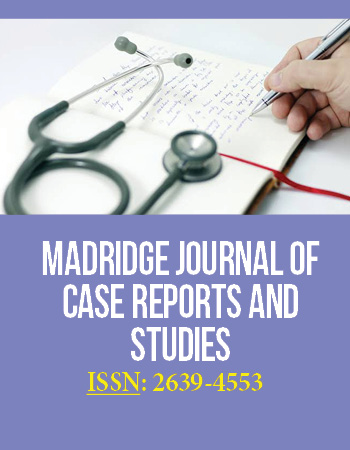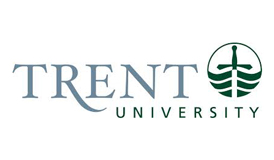Letter to Editor
A Novel Technique to Prevent Head and Neck Injuries during Prone Positioning
1Consultant Anaesthesiologist, Primus Super speciality Hospital, New Delhi, India
2Senior Resident, Department of Anaesthesiology and Intensive Care, Maulana Azad Medical College, New Delhi, India
3Associate Professor, Department of Anaesthesiology and Intensive Care, Maulana Azad Medical College, New Delhi, India
*Corresponding author: Amit Sharma, Senior Resident, Department of Anaesthesiology and Intensive Care, Maulana Azad Medical College, New Delhi, India, E-mail: amitmamc03@gmail.com
Received: January 13, 2020 Accepted: January 20, 2020 Published: January 24, 2020
Citation: Jain G, Sharma A, Gupta L. A Novel Technique to Prevent Head and Neck Injuries during Prone Positioning. Madridge J Case Rep Stud. 2020; 4(1): 170-171. doi: 10.18689/mjcrs-1000145
Copyright: © 2020 The Author(s). This work is licensed under a Creative Commons Attribution 4.0 International License, which permits unrestricted use, distribution, and reproduction in any medium, provided the original work is properly cited.
Dear Editor,
Anaesthesia in prone position has been used for gaining access in a variety of surgeries [1]. Anaesthesiologist is primarily responsible for positioning of the patient along with coordination from entire surgical staff. Long duration of these surgeries along with application of pressure to dependent parts of bodies can lead to a number of complications. Direct pressure sores leading to denudation of skin are well-known sequelae of prone position [2]. Periorbital and malar regions can have pressure necrosis because of such direct pressure area points. During prone surgery, incidence of pressure sores on face is between 5% and 66% [3]. Long duration of surgery and excessive fluid replacement may further increases facial oedema. Pressure on the face in prone position may vary from 30 mmHg to 50 mmHg on certain parts such as the supraorbital ridge forehead and chin [4]. Similarly, excessive prolonged pressure on ears may cause hematoma, chondritis and ischemia on cartilaginous auricles.
A corneal abrasion may be caused due to injury to eye. External compression on the eyeball can lead to post-operative visual loss [4]. Kinking of flexometallic tube leading to blockade is a common occurrence during prone position. Loosening of tape because of drainage of saliva can lead to dislodgement of endotracheal tube. In addition, use of motor evoked potentials can lead to bite injuries of tongue. Tongue swelling resulting in airway obstruction is a known complication in prone surgeries in flexed thoracic-cervical position.
Supportive padded headrests and head elevation are recommended measures to minimize inappropriate pressure on the face. However, these are not always possible as spine flexion especially at lumbar region is sometimes required for adequate access during spinal surgery, thus increasing pressure on the face. We would like to highlight our innovation to prevent head and neck injuries during prone positioning (Figures 1-4). We fix the tube in midline away from molars instead of keeping itunilaterally at one side. Hand rolled gauze pads are put on both sides of tube as bite block. Front of oral cavity is packed with a cotton gauze pack to soak the secretions. Another rectangular shaped gauze pack is put on lips around the tube to prevent injury to lips. Tegaderm is then used to cover the eyes. Face is encircled around the circumference with cotton pads to protect the pressure points. Forehead is also covered with an extra layer of cotton. After this, the patient is turned to prone position without further head elevation. All these measures help in providing injury free anaesthesia to the patient in prone position.
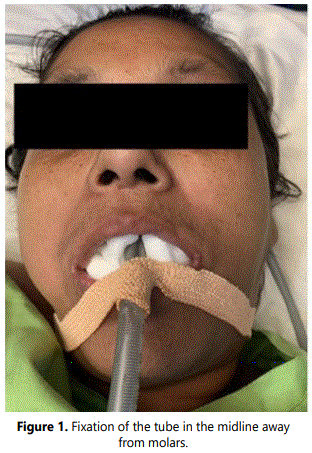
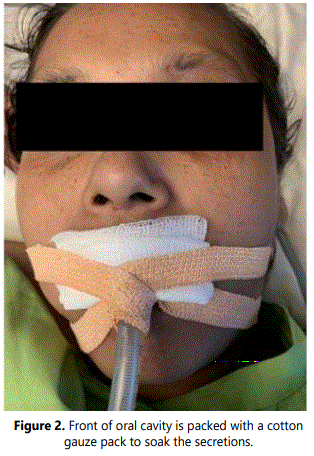
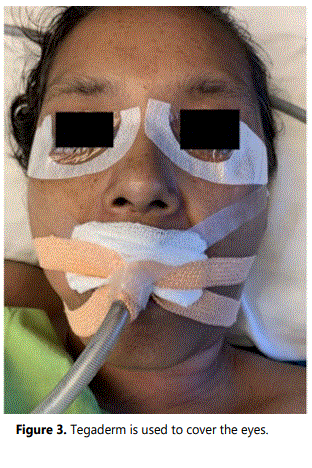
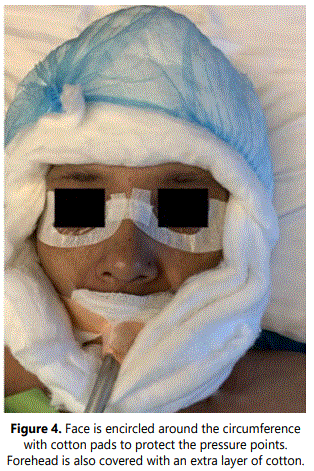
References
- Feix B, Sturgess J. Anaesthesia in the prone position. Continuing Education in Anaesthesia Critical Care & Pain. 2014; 14(6): 291-297. doi: 10.1093/bjaceaccp/mku001
- Edgcombe H, Carter K, Yarrow S. Anaesthesia in the prone position. Br J Anaesth. 2008; 100(2): 165-183. doi: 10.1093/bja/aem380
- Grisell M, Place H. Face tissue pressure in prone positioning: a comparison of three face pillows while in the prone position for spinal surgery. Spine (Phila Pa 1976). 2008; 33(26): 2938-2941. doi: 10.1097/BRS.0b013e31818b9029
- Leibovitch I, Casson R, Laforest C, Selva D. Ischemic orbital compartment syndrome as complication of spinal surgery in the prone position. Ophthalmology. 2006; 113(1): 105-108. doi: 10.1016/j.ophtha.2005.09.025

